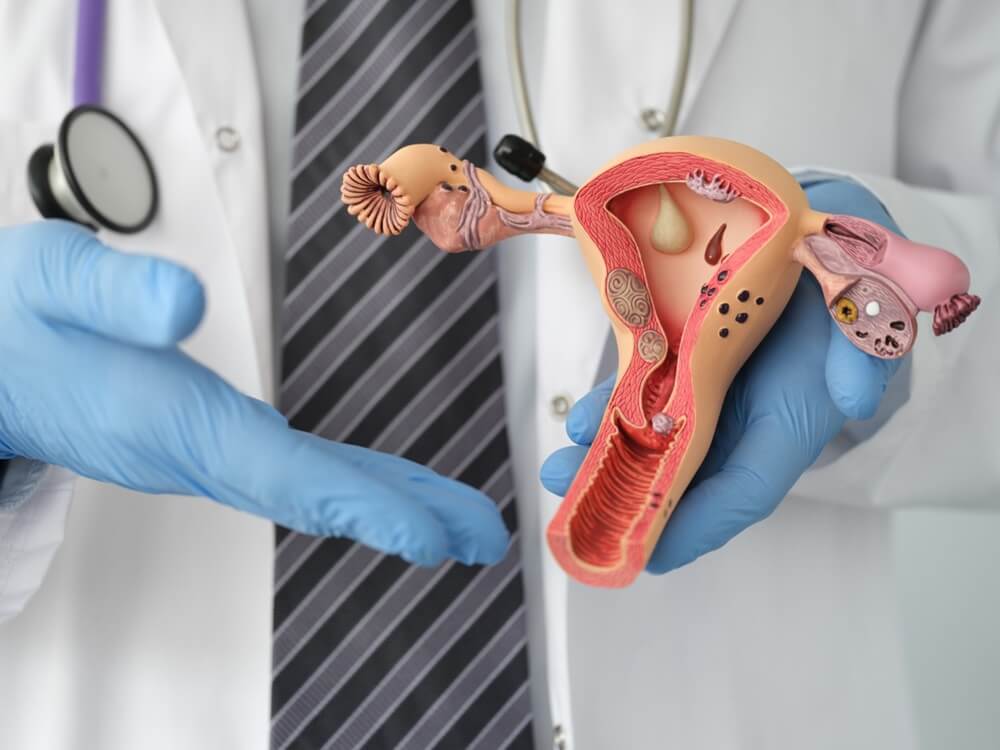
Symptoms of Uterine Fibroids
Uterine fibroids may not cause any symptoms in some cases. Therefore, it depends on the location, size, and number of fibroids. Some of the most common symptoms and signs of uterine fibroids, if they occur, include:
-
Heavy menstrual bleeding.
-
Prolonged menstrual periods lasting more than a week.
-
Feeling of pain or pressure in the pelvis, back, or legs.
-
Frequent urination.
-
Difficulty completely emptying the bladder.
-
Constipation.
-
Severe pain during menstruation or intercourse.
-
Abdominal bloating.
Causes of Uterine Fibroids
In fact, doctors have not yet fully understood the cause of uterine fibroids. However, the following factors are believed to play a role, according to numerous clinical studies and research:
Genetic changes: Gene alterations may be a cause of many uterine fibroids.
Hormones: Increased levels of estrogen and progesterone may stimulate the growth of uterine fibroids, as fibroids have many receptors for these hormones.
Other growth factors: Growth factors like insulin-like growth factor, which plays a role in maintaining body tissues, may affect fibroid growth.
Risk Factors for Uterine Fibroids
There are several factors that influence the development of uterine fibroids, as explained by Dr. Fareed Al Adham, including:
-
Age: Uterine fibroids are more common in women between their thirties and early fifties, and fibroids may shrink after menopause.
-
Genetics: A woman is more likely to develop uterine fibroids if a first-degree relative such as her sister or mother has them.
-
Early onset of menstruation.
-
Obesity.
-
Vitamin D deficiency.
-
Alcohol consumption.
-
Unhealthy diet: A diet low in green vegetables and fruits, and high in red meat.
Diagnosis of Uterine Fibroids
Uterine fibroids are often diagnosed through ultrasound examination, and it may require a biopsy to take a sample of the fibroid tissue and subject it to laboratory examination to confirm that it is benign and noncancerous. Additionally, the doctor may recommend other tests, including:
-
Laboratory tests: Such as complete blood count (CBC) or hormone tests to rule out any other health problems that may cause similar symptoms.
-
Magnetic resonance imaging (MRI): It helps to clarify the location, size, and types of uterine fibroids, along with choosing the appropriate treatment.
-
Hysterosalpingography: It has a role in producing images of uterine fibroids and the uterine lining after using certain materials to expand the uterine cavity and imaging it.
-
Hysterosalpingogram: It helps to show some uterine fibroids by using a dye that helps to highlight the uterine cavity.
Treatment for Uterine Fibroids
Dr. Fareed Al Adham assures his patients that most cases of uterine fibroids do not require specific treatment if they do not cause symptoms. However, women should undergo regular check-ups to monitor any changes in fibroids. If they cause symptoms or troublesome complications, treatment may be necessary depending on the location, size, and symptoms they cause. Treatments offered by Dr. Fareed Al Adham in his clinic include:
Hormonal Treatments
They play a role in reducing heavy bleeding and pain or decreasing the size of fibroids. These include:
-
Oral contraceptives.
-
Progestin-releasing intrauterine devices.
-
Gonadotropin-releasing hormone agonists.
Surgery
If previous treatments fail or if the fibroids are very large, they may need to be surgically removed. These include:
-
Embolization or interventional radiology (uterine artery embolization): This procedure involves blocking blood flow to the fibroids, causing them to shrink.
-
Surgical removal of uterine fibroids.
-
Surgical removal of the uterine lining.
-
Hysterectomy in some cases.
